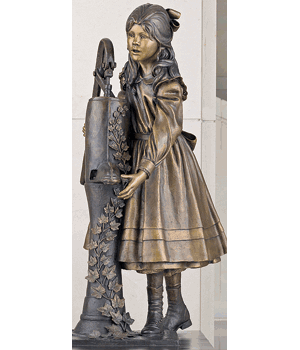

Architect of the Capitol photo
The National Statuary Hall in the United States Capitol in Washington, D.C. has 100 statues donated by individual states to honor notable leaders in their state’s history. Even before the completion of the present House wing in 1857, the idea of a National Statuary Hall was considered.
Representative Justin S. Morrill, April 19, 1864 proposed that the Chamber be used “for the reception of such statuary as each State shall elect to be deserving of in this lasting commemoration.” His proposal became law July 2, 1864. Due to over-crowding, a resolution in 1933 decided that only one statue from each state should be placed in Statuary Hall. The others would be given prominent locations in designated areas and corridors of The Capitol Building.
Statues representing 10 of the 13 original colonies were moved to the Central Hall of the East Front Extension on the first floor of the Capitol. In recent years the statues have been unveiled during ceremonies in the Rotunda and displayed there for up to six months. They are moved to a permanent location approved by the Joint Committee on the Library. An act of Congress enacted in 2000 permits states to provide replacements and repossess any earlier one.
It probably should not come as a surprise that only nine of the 100 statues in Statuary Hall, Congress, are of women: Accomplished, productive, intelligent women. Each state has been allowed to nominate two distinguished leaders for sculptors to fashion and then stand in the Congress Statuary Hall.
Think of all the women through the decades who have led and created and stood tall and yet the powers that be selected only nine for this distinction. Think of the Mary Colters who designed and was the architect of the Grand Canyon National Park or Jane Addams or Betsy Ross or thousands of other women leaders who should be considered.
The women included are Frances E. Willard, whose statue was sculpted by a woman. Helen Farnsworth Mears, Helen Keller, Florence Sabin, Maria Sanford, Jeannette Rankin who was the first woman elected to the House and the only member of Congress to vote against U.S. entry into both World Wars. Sakakewa and Sarah Winnemucca, two of the five Native Americans in the collection. Mother Joseph and Esther Hobart Morris. If any of these names are unfamiliar to you, look up their accomplishments and determine why they have been included. If you are counting these names and come up with 10, that is because Sakakewa is considered a Native American rather than a Native American woman.
Statuary Hall has several statues of leaders of the Confederate State of America and they are all men who engaged in rebellion against the government that now honors them. Those names include Jefferson Davis, Alexander Stephens, Robert E. Lee, Wade Hampton III, and Edmund Kirby Smith. The first person of Hispanic descent to be elected to a full term in the U.S. Senate was Dennis Chavez, D-New Mexico, who served in the U.S. Senate from 1935-1962 and he has a statue.
As of June 2015 California began considering replacing its statue of Junipero Serra with one of astronaut Sally Ride. North Carolina has requested the replacement of Charles Aycock with one of the Reverend Billy Graham. However, legislation governing donation and replacement of statues state they must represent deceased individuals. Reverend Graham died February 21, 2018. So the statue could be considered.
Ohio replaced its statue of William Allen with inventor and businessman Thomas Edison in 2016. Allen’s statue was returned to his hometown of Chillicothe. Arizona replaced its statue of John Campbell Greenway in 2015 with one of Barry Goldwater. The Greenway statue is at the Polly Rosenbaum Archives History Building nearer the Arizona State Capitol in Phoenix.

